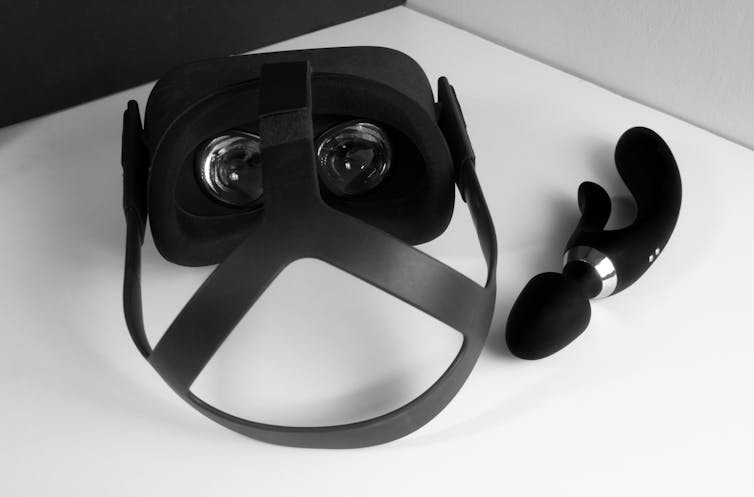
Sex toys are fairly common in people’s sex lives, and broadly accessible both online and in brick-and-mortar stores. In the United States, more than 40 per cent of heterosexual women and men have incorporated vibrators into the bedroom.
More than three-quarters of Canadians have used a sex toy with a partner at least once, including vibrators, anal toys and penile masturbators. Reported rates also vary widely across western countries — for instance, 16 per cent of Australians say they’ve used sex toys while up to 52 per cent of people in Germany say they have.
However, sex toys are no longer limited to the analogue dildos and masturbators of the past. Today, they have become increasingly sophisticated.
Internet-connected toys, known as teledildonics, are novel devices designed to enhance sexual experiences by mimicking elements of real human intimacy — such as genital touch, body warmth, synchronized movements or orgasmic sensations — without a partner being physically present.
They can be synced with online pornography, integrated with virtual reality or even controlled remotely by a partner, allowing for intimacy at a distance.
One question remains as this burgeoning technology becomes integrated in individuals’ lives: Can teledildonics promote sexual well-being?
Why people use sex toys
Research reveals that using sex toys, whether on their own or with a partner, is linked with greater sexual satisfaction. One study also found that using a vaginal vibrator helped women experience stronger arousal, better lubrication and reach orgasm more easily.
People use sex toys for all sorts of reasons. In one Canadian study, the most popular reason people used sex toys was to spice up their sex life with a sexual partner.
Other commonly reported motivations included wanting to boost sexual arousal during masturbation and partnered sex, and to reach orgasm more easily. For a smaller proportion, sex toys also served to help them relax or release tension.
What about teledildonics?
In one survey, nine per cent of U.S. adults reported they’ve used teledildonics, with more men (15 per cent) reporting usage than women (five per cent) and gender-diverse individuals (13 per cent).
Although more and more people are turning to teledildonic devices, we still know relatively little about why they use them or how they relate to well-being — especially compared to the growing body of research on traditional, non-connected sex toys.
Our research team at the Université du Québec à Montréal surveyed 617 men between the ages of 19 and 75 years old. They were customers of the teledildonics company, Kiiroo, which specializes in interactive, app-connected sex toys, particularly for men, such as masturbatory sleeves and strokers. Kiiroo’s marketing team helped recruit participants for the survey.
This industry collaboration allowed us to explore, for the first time, who uses these devices, why they use them, and how certain usage patterns like using it alone or with a partner may support greater sexual well-being.

Most of our participants resided in North America (74 per cent) and Europe (22 per cent), while a minority were in Australia, Asia and Central America (three per cent combined). They primarily identified as white (75 per cent), Asian (17 per cent), Latin American (10 per cent) and Black (four per cent).
In our study, nearly all the men used their teledildonic devices alone, but 21 per cent of them also reported incorporating them into partnered sex.
We found that people who use teledildonics with a partner tend to own a greater number of these devices compared to those who use them solely for solo play.
Partnered use was also associated with a higher number of previous sexual partners, which may suggest that greater sexual experience increases one’s comfort in sharing sex toy use with a partner.
Finally, partnered use was associated with greater sexual well-being in men. Those who used their toys with a partner reported having greater sexual desire, more ease in reaching orgasm with a partner and increased confidence as a sexual partner.
In other words, men who use their teledildonics with a partner may experience greater sexual well-being than men who only use their devices alone.

Why do men use teledildonics?
Our study was the first to uncover the motivations behind men’s teledildonic sex toy use.
For 57 per cent of the men in our study, teledildonics were used primarily to relax or relieve tension. Just over half also reported using teledildonics to fantasize about sexual activities that are not possible in real life and to increase sexual arousal during masturbation.
More than one third of participants (38 per cent) shared that their teledildonics usage was specifically motivated by the ability to connect their toys with other technologies (like virtual reality headsets or online pornography).
Other motivations for using teledildonics appear to mirror many of those that drive traditional sex toy use, notably relaxation and tension relief and to increase arousal.
What’s next for teledildonics?
Taken together, these findings offer promising evidence that using teledildonics, particularly with a partner, can have sexual benefits. They also invite us to reflect on how such technologies could improve the sex lives of people facing challenges such as sexual dysfunction, physical disabilities or a lack of access to sexual partners — although further research is needed to understand how teledildonics can meet their specific needs.
In addition, this growing industry raises important questions around data security, ethics and digital consent, including how to address concerns about the devices being hacked or remotely controlled without permission.
Ensuring that these technologies are developed with privacy and safety in mind is essential to maximizing their impact as tools that support sexual well-being in a rapidly changing sexual landscape.
As teledildonics and other sex technologies become more sophisticated, they will continue to transform the future of sex, intimacy and well-being.
Madison E. Williams consults for Kiiroo.
David Lafortune received funding from Kiiroo to conduct this study.
Éliane Dussault consults for Kiiroo.
This article was originally published on The Conversation. Read the original article.







